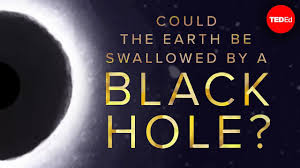(单词翻译:单击)
From asteroids capable of destroying entire species, to gamma-ray bursts and supernovae that could exterminate life on Earth,
从能够毁灭整个物种的小行星,到能够毁灭地球上所有生灵的伽马射线暴和超新星,
outer space has no shortage of forces that could wreak havoc on our tiny planet.
外太空从来不缺可能对我们这颗小小的星球造成巨大灾难的力量。
But there's something in space that seems more terrifying than any of these -- something that wipes out everything it comes near.
但是太空中似乎还有比这些力量更加恐怖的存在--任何东西一旦靠近它就会彻底消失。
Could the Earth be swallowed by a black hole?
地球会被黑洞吞噬吗?
A black hole is an object so dense that space and time around it are inescapably modified, warped into an infinite sink.
黑洞是一个密度如此之大的物体,以至于它周围的空间和时间都不可避免地发生改变,弯曲成一个无尽的槽型深渊。
Nothing, not even light, can move fast enough to escape a black hole's gravitational pull once it passes a certain boundary, known as the event horizon.
任何东西一旦越过某个边界,这被称为视界,即使是光也不能以足够快的速度逃脱黑洞的引力。
Thus, a black hole is like a cosmic vacuum cleaner with infinite capacity, gobbling up everything in its path, and letting nothing out.
因此,黑洞就像一个容量无限的宇宙吸尘器,吞噬它所经之处的一切,不让任何东西出去。
To determine whether a black hole could swallow the Earth, we first have to figure out where they are.
为了断定黑洞是否会吞噬地球,我们首先要弄清楚它们在哪。
But since they don't emit light, how's that possible?
但它们本身不发光,怎么找得到?
Fortunately, we're able to observe their effect on the space around them.
幸运的是,我们能够观察到它们对周围空间的影响。
When matter approaches a black hole, the immense gravitational field accelerates it to high speed.
当物质接近黑洞时,巨大的引力场使它加速到很高的速度。
This emits an enormous amount of light.
这就产生了大量的光。
And for objects too far away to be sucked in, the massive gravitational force still affects their orbits.
对于太远而无法被吸入的物体,巨大的引力仍然会影响其轨道。
If we observe several stars orbiting around an apparently empty point, a black hole could be leading the dance.
如果我们观察到几颗恒星围绕着一个明显的空点翩翩起舞,那么黑洞可能是领舞者。
Similarly, light that passes close enough to an event horizon will be deflected in a phenomenon known as gravitational lensing.
同理,足够接近视界的光会因为引力透镜效应而发生偏转。
Most of the black holes that we've found can be thought of as two main types.
我们发现的黑洞大多数可以归为下面两种主要类型。
The smaller ones, called stellar mass black holes, have a mass up to 100 times larger than that of our sun.
其中较小的黑洞被称为恒星质量黑洞,其质量比我们的太阳大100倍。

They're formed when a massive star consumes all its nuclear fuel and its core collapses.
它们是由核燃料耗尽后核心坍缩的大质量恒星演变而来的。
We've observed several of these objects as close as 3000 light-years away,
我们已经在3000光年外的地方观察到了若干个这样的天体,
and there could be up to 100 million small black holes just in the Milky Way galaxy.
而且单是银河系中就有将近一亿个小型黑洞。
So should we be worried? Probably not.
要不要为此担忧?很可能不用。
Despite their large mass, stellar black holes only have a radius of around 300 kilometers or less, making the chances of a direct hit with us miniscule.
尽管它们质量很大,但恒星黑洞的半径只有大约300公里或更小,因此我们被直接击中的可能性微乎其微。
Although because their gravitational fields can affect a planet from a large distance, they could be dangerous even without a direct collision.
然而它们的引力场能从很远的距离影响行星,所以即使没有直接碰撞,也可能存在危险。
If a typical stellar-mass black hole were to pass in the region of Neptune, the orbit of the Earth would be considerably modified, with dire results.
假如一个典型的恒星质量黑洞经过海王星区域,那么地球的轨道将会发生相当大的改变,后果不堪设想。
Still, the combination of how small they are and how vast the galaxy is means that stellar black holes don't give us much to worry about.
不过,它们是如此之小,星系又是如此之广阔,两者结合起来看,恒星黑洞没什么令人担忧的地方。
But we still have to meet the second type: supermassive black holes.
但我们仍会遇到第二种类型:超大质量黑洞。
These have masses millions or billions times greater than that of our sun and have event horizons that could span billions of kilometers.
它们的质量比我们太阳的质量大数百万或数十亿倍,其视界可跨越数十亿公里。
These giants have grown to immense proportions by swallowing matter and merging with other black holes.
这些庞然大物通过吞噬物质以及与其他黑洞合并而变得巨大。
Unlike their stellar cousins, supermassive black holes aren't wandering through space.
和它们的恒星表亲不同,超大质量黑洞不会在太空中游移。
Instead, they lie at the center of galaxies, including our own.
相反,它们位于星系的中心,我们自己的星系也是如此。
Our solar system is in a stable orbit around a supermassive black hole that resides at the center of the Milky Way, at a safe distance of 25,000 light-years.
我们太阳系以稳定轨道和25000光年的安全距离,围绕着一个处在银河系中心的超大质量黑洞旋转。
But that could change. If our galaxy collides with another, the Earth could be thrown towards the galactic center,
但这种情况可能会改变。如果我们的星系与另一个星系相撞,地球可能会被抛向银河系中心,
close enough to the supermassive black hole to be eventually swallowed up.
距离超大质量黑洞足够近,导致最终被吞噬。
In fact, a collision with the Andromeda Galaxy is predicted to happen 4 billion years from now, which may not be great news for our home planet.
事实上,据预测,与仙女座星系的碰撞将会在40亿年后发生,这对于我们赖以生存的星球来说可能不是什么好消息。
But before we judge them too harshly, black holes aren't simply agents of destruction.
但我们不要急着对它们作出严厉的评判,黑洞并不仅仅是毁灭凶手。
They played a crucial role in the formation of galaxies, the building blocks of our universe.
它们在宇宙的基石,在星系的形成过程中扮演了至关重要的角色。
Far from being shadowy characters in the cosmic play, black holes have fundamentally contributed in making the universe a bright and astonishing place.
黑洞与宇宙中阴暗神秘的角色相去甚远,它们在打造一个光明而令人惊叹的宇宙这方面作出了基础的贡献。


